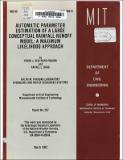| dc.contributor.author | Restrepo Posada, Pedro J. | en_US |
| dc.contributor.author | Bras, Rafael L. | en_US |
| dc.date.accessioned | 2022-06-13T13:09:34Z | |
| dc.date.available | 2022-06-13T13:09:34Z | |
| dc.date.issued | 1982-03 | |
| dc.identifier | 267 | |
| dc.identifier.uri | https://hdl.handle.net/1721.1/143012 | |
| dc.description | Hydrologic Research Laboratory of the National Weather Service, U.S. Dept. of Commerce NA 80AA-H-00044 | en_US |
| dc.description.abstract | A stochastic parameter estimation procedure to be applied to large conceptual rainfall-runoff models is proposed. The procedure is based on a maximum likelihood approach, which is enhanced to allow for the use of prior information about some of the parameters. A stochastic model of base flow is proposed, and an algorithm for automatic identification of the time interval of base flow activity is developed. This algorithm, which permits the estimation of prior values for the base flow discharge coefficients, is successfully applied to two basins in the United States. The application of the maximum likelihood estimation procedure to large conceptual rainfall-runoff models is divided into two stages. In the first stage the procedure is applied to a simplified version of the National Weather Service River Forecasting System model, the parameters of which are estimated by using synthetically generated data. This stage produces valuable information about the performance of stochastic parameter estimation procedures in large conceptual rainfall-runoff models. In the second stage the maximum likelihood procedure is applied to estimating the parameters of the National Weather Service River Forecasting System model for the Bird Creek and for the Cohocton River basins, respectively. In the first case a severe structural error arising from a deficient formulation of the channel causes some of the parameters to converge to unrealistic values. In the second case the stochastic model performs in a mathematically correct but hydrologically unappealing fashion. The reasons for this problems are attributed to the non-identifiability of the threshold parameter of the upper zone tension water element and to interaction between several of the percolation function parameters. | en_US |
| dc.publisher | Cambridge, Mass. : Ralph M. Parsons Laboratory, Hydrology and Water Resources Systems, Dept. of Civil Engineering, Massachusetts Institute of Technology | |
| dc.relation.ispartofseries | R (Massachusetts Institute of Technology. Department of Civil Engineering) ; 82-05. | |
| dc.relation.ispartofseries | Report (Ralph M. Parsons Laboratory for Water Resources and Hydrodynamics) ; 267. | |
| dc.title | Automatic Parameter Estimation of a Large Conceptual Rainfall-runoff Model: A Maximum Likelihood Approach | en_US |
| dc.identifier.oclc | 9437777 | |
| dc.identifier.aleph | 241832 | |
